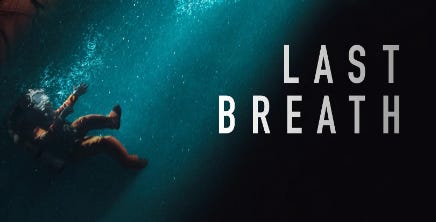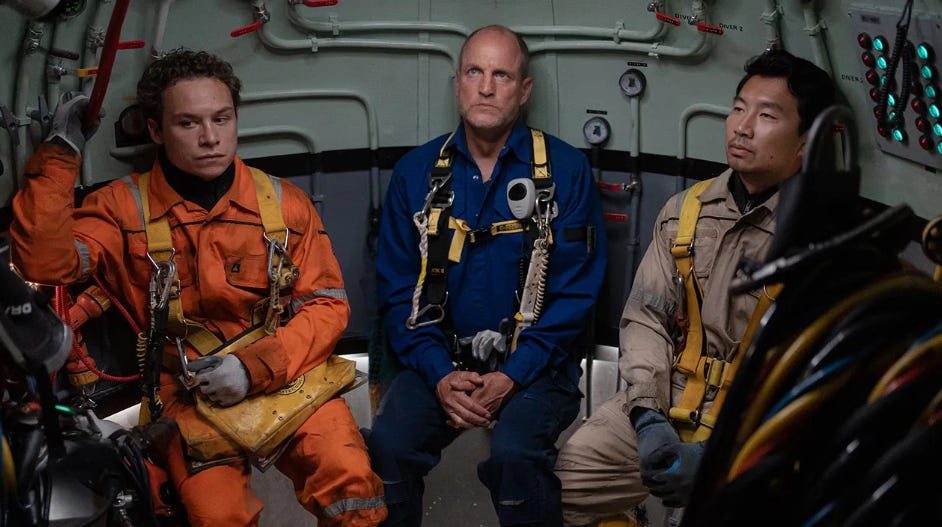"Last Breath" Will Take Your Breath Away
This disaster movie is a no-risk film for anybody, including families with older kids
Amid today’s perpetual rancor of news and social-media barking, along comes “Last Breath” to give us all a bit of encouragement.
This underwater disaster-film showcases humans working together to save each other. And they do so in the face of utilitarian considerations and against all reasonable scientific knowledge, without the help of AI.
The movie tells you it’s “a true story,” and not just based on a true story. It recounts a 2012 diving accident in which an offshore diver, working on a deep-ocean gas pipeline, gets cut off and left behind the ship that supports his life.
And he’s not just briefly left behind. He goes without oxygen for almost thirty minutes! Do you think he survives?
Since I’ve already told you the essence of the plot, please know that the film has two awesome things going for it:
It meticulously details how a ship and its entire crew engage in maintenance of gas pipelines, the kind that keep your homes warm in winter. That’s down to the ship’s controls and computer displays, and the texture of the umbilical-cord rope that keeps the divers connected to the “bell,” the small underwater hub which they dive down into ocean darkness from.
The underwater portion of the film is harrowing on the big screen. “2001: A Space Odyssey” is used to great effect, including the soundscape of breathe only at times. Several shots are hauntingly beautiful.
That meticulous detail extends to the compression chamber the divers must use to both compress and decompress. To prep for diving upwards of 1000 feet down, they hang out in a double-compartment cylinder that would make the “Das Boot” crew feel claustrophobic. Their stint in that cylinder is an amazing, horrifying 28 days, plus four days where they sit in it and wait as they decompress back to one-atmosphere.
Some of them, incredibly, love it.
The movie focuses on a team of three, played by Woody Harrelson, Simu Liu, and Finn Cole, all of whom share the cylinder and make up the diving team. The Harrelson character is the classic-but-cliched veteran who’s on his last mission. Perplexingly, he doesn’t want to give up his cozy claustrophobic job, which the opening credits tell us is one of the most dangerous jobs in the world.
Besides the divers, there’s an entire ship that has a bit of the realistic flair of the Starship Enterprise. That includes the captain, played by veteran actor Cliff Curtis, and the lead communicator with the divers, played by another veteran actor Mark Bonnar.
At one point the ship’s computers go down, causing the accident, and it’s up to a Scotty-like figure to fix the computer. After all, the ship is basically Scottish!
I loved the underwater portion of the film, including the sense and vision that the divers have in their dark habitat. It’s been a couple years since I gasped out loud during a film, but here it happened. Part of that was my astonishment at the fact these guys work down there with 1000+ psi pipelines. (I used to work as an oilfield hand, and 500 psi was more than enough for me!)
While the movie doesn’t really know exactly how to begin or end, relying on the old-standby romance plot to bring home the true tension of the lost diver, everything else recommends it as a solid disaster film.
As well, I recommend it strongly for older kids. The MPA, proving its uselessness, warns us about the film’s “brief strong language.” That’s hardly in there, and it’s nothing compared to the dark peril that the divers are in during half the film.
That dark peril is the ultimate fear, which is of death. The divers jump off at one point into a total abyss of darkness, in shots that Werner Herzog would love. And later, one diver is completely left behind, groping in the darkness, lighting his one red flair, hoping that no one forgets about him.
If they do forget him, then what’s death like? He’ll tell us.
He can say because he’s a kind of Lazarus, although a cold and wet one.






